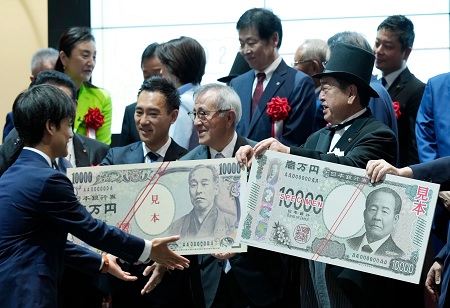
Japan Rolls Out New Yen Notes with 3D Holograms to Combat Fake Bills

 Japan has unveiled its first new banknotes in twenty years, featuring advanced 3D hologram technology aimed at combating counterfeiting. Prime Minister Fumio Kishida hailed the state-of-the-art anti-counterfeit features of the new 10,000 yen, 5,000 yen, and 1,000 yen bills as historic. “I hope the people will like the new bills, and they will help energize the Japanese economy”, he told reporters at the Bank of Japan.
Japan has unveiled its first new banknotes in twenty years, featuring advanced 3D hologram technology aimed at combating counterfeiting. Prime Minister Fumio Kishida hailed the state-of-the-art anti-counterfeit features of the new 10,000 yen, 5,000 yen, and 1,000 yen bills as historic. “I hope the people will like the new bills, and they will help energize the Japanese economy”, he told reporters at the Bank of Japan.
Despite the high-profile release of the new bills, existing currency will remain legal tender. According to local media reports, older bills will still be necessary for most vending machines and bus fares. Kishida highlighted that the individuals depicted on the bills symbolize Japanese achievements in capitalism, women's equality, and scientific progress.
The 10,000 yen bill, valued at approximately $62 based on current exchange rates, features Eiichi Shibusawa, renowned as "the father of Japanese capitalism" and a pivotal figure in Japan's economic modernization. Credited with establishing numerous companies, Shibusawa played a crucial role in shaping Japan's economy.
The 5,000 yen bill, valued at approximately $30, showcases Umeko Tsuda, a trailblazing feminist and educator who founded a college. On the 1,000 yen note, worth about $6.20, is Shibasaburo Kitasato, a renowned physician and bacteriologist known for his significant contributions to the study of tetanus and the bubonic plague.
On the reverse side, each of the bills showcases Tokyo Station, wisteria flowers, and Mount Fuji by ukiyo-e artist Katsushika Hokusai. Additionally, the new banknotes have larger print to enhance readability, particularly beneficial for Japan's aging population. The government plans to print nearly 7.5 billion of these new banknotes by the end of March next year. It is estimated that approximately 1.6 trillion yen (about $10 billion) worth of these new bills will be circulated in a single day.
Acquiring the new bills may initially pose a challenge for the general public. Initially, they will be distributed to banks and other financial institutions before being made available at ATMs and stores, as outlined by the Bank of Japan. Cash remains the predominant mode of transaction in Japan, with cashless payments slower to gain widespread adoption compared to many other countries. “Although the world is moving toward cashless interactions, we believe cash remains important as a way for safely settling payments anywhere and anytime”, said Bank of Japan Gov. Kazuo Ueda.

